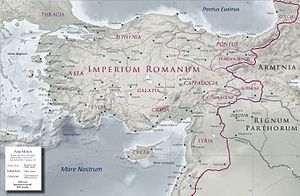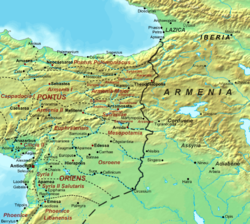| This article needs additional citations for verification. Please help improve this article by adding citations to reliable sources. Unsourced material may be challenged and removed. Find sources: "Lesser Armenia" – news · newspapers · books · scholar · JSTOR (January 2023) (Learn how and when to remove this message) |
| Part of a series on the |
|---|
| History of Armenia |
 |
| Prehistory |
| Antiquity |
| Middle Ages |
| Early modern age |
| Modern age |
| Timeline • Origins • Etymology |
Lesser Armenia (Armenian: Փոքր Հայք, romanized: P’ok’r Hayk’; Latin: Armenia Minor; Ancient Greek: Mικρά Αρμενία, romanized: Mikrá Armenía), also known as Armenia Minor and Armenia Inferior, comprised the Armenian-populated regions primarily to the west and northwest of the ancient Kingdom of Armenia (also known as Kingdom of Greater Armenia), on the western side of the Euphrates River. It was also a kingdom, separate from Greater Armenia, from the 2nd century BC to the 1st century AD. The region was later reorganized into the Armeniac Theme under the Byzantine Empire.
Geography
Further information: Western Armenia; Central Anatolia Region, Turkey; and Black Sea Region, TurkeyLesser Armenia (or Armenia Minor) was the portion of historic Armenia and the Armenian Highlands lying west and northwest of the river Euphrates. It received its name to distinguish it from the much larger eastern portion of historic Armenia—Greater Armenia (or Armenia Major).
Early history


Lesser Armenia corresponded to the location of the Late Bronze Age Hayasa-Azzi confederation, which is thought by some scholars to be the source of the Armenian endonym hay and the original state of the Proto-Armenians. It has been suggested that the epithet "lesser" indicates that this territory was the older homeland of the Armenian people, while "greater" Armenia referred to a territory that was later settled.
Lesser Armenia may have formed a part of the territories of the Orontid dynasty, which ruled Armenia first as satraps of the Achaemenid Empire and then as kings. However, there is no clear evidence to support this claim. Lesser Armenia emerged as a separate kingdom after the Treaty of Apamea in 188 BC, although the exact origin, size and history of this kingdom are murky. The capital of this kingdom was probably originally at Kamakh, but likely moved to Nicopolis after the end of the Mithridatic Wars. Lesser Armenia apparently experienced the high point of its territorial expansion during the Orontid period, possibly expanding its borders to the Black Sea. According to Strabo, it originally had its own royal dynasty. It passed under the control of the Kingdom of Pontus in the 1st century BC, during the reign of Mithridates VI Eupator (r. 120 – 63 BC), who built 75 fortresses there. After the Romans defeated Pontus in the Mithridatic Wars, Lesser Armenia became a client kingdom of Rome, who appointed various client kings to rule the kingdom. The last of these was Aristobulus of Chalcis of the Herodian dynasty. In 72 AD, Lesser Armenia was annexed by the Roman Empire and made a part of the larger province of Cappadocia.

Roman and Byzantine Lesser Armenia
Further information: Roman ArmeniaAll of Armenia became a Roman province in AD 114 under Roman emperor Trajan, but Roman Armenia was soon after abandoned by the legions in 118 AD and became a vassal kingdom. Lesser Armenia, however, was generally incorporated by Trajan, together with Melitene and Cataonia, into the province of Cappadocia. Lesser Armenia consisted of five districts: Orbalisene in the North; below that Aetulane; Aeretice; then Orsene; and finally Orbesine, the most southern. The more southern districts appended to Lesser Armenia were Meleiene, so called from its capital Melitene (modern Malatya) and the following four small districts of ancient Cataonia, namely, Aravene; Lavinianesine or Lavianesine; Cataonia, in the more restricted sense, or the country close upon Cilicia surrounded by mountains; finally, Muriane or Murianune, between Cataonia and Melitene, called likewise Bagadoania.
Lesser Armenia was reunited with the kingdom of Greater Armenia under the Arshakuni king Tiridates III in AD 287 until the temporary conquest of Shapur II in 337.
Then it was formed into a regular province under Diocletian, and in the 4th century, was divided in two provinces: First Armenia (Armenia Prima), which contained most of Lesser Armenia, and Second Armenia (Armenia Secunda) that comprised all the southern tracts which had been added to Lesser Armenia, with the exception of Cataonia, which was incorporated with Cappadocia Secunda.
Its population remained Armenian but was being gradually Romanized. Since the 3rd century many Armenian soldiers were in the Roman army: later–in the 4th century–they made up two Roman legions, the Legio I Armeniaca and the Legio II Armeniaca.
In 536, the emperor Justinian I reorganized the provincial administration, and First and Second Armenia were renamed Second and Third respectively, while some of their territory was split off to the other Armenian provinces.
The borders of the Byzantine part of Armenia were expanded in 591 into Persarmenia, but the region was the focus of decades of warfare between the Byzantines and the Persians (the Byzantine-Sassanid Wars) until the Arab conquest of Armenia in 639.
After this, the part of Lesser Armenia remaining under Byzantine control (in a lesser extent) became part of the theme of Armeniakon.
Mongol and Ottoman influence
After the downfall of Bagratid Armenia in 1045 and resulting subsequent losses of Byzantine Empire in the East after the Battle of Manzikert in 1073, Lesser Armenia fell to the Seljuks and then was part of the Mongol Empire for 92 years and of the Ottoman Empire from the late 15th century.
Between the 11th and 14th centuries, the term Lesser Armenia (sometimes called "Little Armenia") was applied to the Armenian Kingdom of Cilicia, right until the formation of Turkey in 1923.
Episcopal sees
Ancient episcopal sees of the Roman province of Armenia Prima (I) listed in the Annuario Pontificio as titular sees:
- Berissa
- Colonia in Armenia (Köylühisar) (Armenian Catholic Church)
- Nicopolis in Armenia
- Pedachtoë (Bedochton, Pedachton)
- Satala in Armenia
- Sebastea (Sivas)
- Sebastopolis in Armenia (Sulusaray)
Ancient episcopal sees of the Roman province of Armenia Secunda (II) listed in the Annuario Pontificio as titular sees:
- Arabissus
- Arca in Armenia (Arga)
- Ariarathia (Aziziye)
- Comana Armeniae (Sar or Sarkale)
- Cucusus (Göksun)
- Melitene (Malatya)
- Verissa
For ancient episcopal sees of the Roman province of Armenia Tertia (III), see Roman Armenia#Episcopal sees.
Later history
Lesser Armenia is traditionally considered as part of Western Armenia, especially after the acquisition of Eastern Armenia by the Russian Empire in the aftermath of the Russo-Persian War of 1826-1828.
The Christian Armenian population of Lesser Armenia continued its existence in the area until the Armenian genocide of 1915–23. Some Armenians still live in the area, albeit converted to Islam under Ottoman influence, mainly in the 17th century.
See also
Notes
- Adontz 1970, p. 311.
- ^ Harutiunian 1986, p. 373a.
- ^ Petrosyan 2014, p. 108.
- Petrosyan 2007, p. 43.
- ^ Hewsen 2001, p. 32.
- ^ Hewsen 2001, pp. 32, 37.
- ^ Hewsen 2001, p. 37.
- Hewsen 2001, pp. 37, 48.
- Peter Edmund Laurent (1830). An Introduction to the Study of Ancient Geography. With copious indexes. Oxford: Henry Slatter. pp. 233–234.
- Peter Edmund Laurent (1830). An Introduction to the Study of Ancient Geography. With copious indexes. Oxford: Henry Slatter. p. 234.
- ^ Annuario Pontificio 2013 (Libreria Editrice Vaticana 2013 ISBN 978-88-209-9070-1), "Sedi titolari", pp. 819-1013
- Timothy C. Dowling Russia at War: From the Mongol Conquest to Afghanistan, Chechnya, and Beyond pp 729 ABC-CLIO, 2 dec. 2014 ISBN 1598849484
References
- Adontz, Nicolas (1970). The Reform of Justinian Armenia. Translated with partial revisions, a bibliographical note, and appendices by Nina G. Garsoïan. Lisbon: Calouste Gulbenkian Foundation.
- Chahin, Mack (2001). The Kingdom of Armenia: A History. London: Routledge. ISBN 0-7007-1452-9.
- Harutiunian, B. (1986). "Pʻokʻr Haykʻ" Փոքր Հայք. Haykakan sovetakan hanragitaran Հայկական սովետական հանրագիտարան [Armenian Soviet Encyclopedia] (in Armenian). Vol. 12. Yerevan. pp. 373–374.
{{cite book}}: CS1 maint: location missing publisher (link) - Hewsen, Robert H. (2001). Armenia: A Historical Atlas. University Of Chicago Press. ISBN 0-226-33228-4.
- "Kingdom of Greater Armenia". Oxford Reference. Retrieved 20 November 2013.
- Petrosyan, Armen (2014). Armenovedcheskie issledovanii͡a Арменоведческие исследования [Armenological studies] (in Russian). Yerevan: Antares. ISBN 978-9939-51-697-4.
- Petrosyan, Armen (2007). "The Problem of Identification of the Proto-Armenians: A Critical Review". Journal of the Society for Armenian Studies. 16: 43.
- Vaux, Bert (2001). Hemshinli: The Forgotten Black Sea Armenians (PDF). Harvard University. Archived from the original (PDF) on 15 March 2007.
| History of Anatolia | |
|---|---|
 |
| Late Roman and early Byzantine provinces (4th–7th centuries AD) | |||||||||||||||||||||||||
|---|---|---|---|---|---|---|---|---|---|---|---|---|---|---|---|---|---|---|---|---|---|---|---|---|---|
| |||||||||||||||||||||||||
| |||||||||||||||||||||||||
| |||||||||||||||||||||||||
| |||||||||||||||||||||||||
40°41′24″N 39°37′48″E / 40.6900°N 39.6300°E / 40.6900; 39.6300
Categories:
